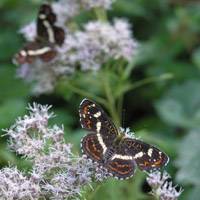* Japanese name: Sakahachichou
* Scientific name: Araschnia burejana strigosa
* Description: These are feisty butterflies, with a wingspan of about 5 cm and sharp, erratic flight. In terms of coloration, red, orange and brown usually predominate. The forelegs are merely "brushes," and are not used for walking. The Japanese name, sakahachi, refers to the Chinese character for 8.
* Where to find them: In parks and meadows near broad-leaved and mixed forests; also in mountainous, forested areas from Honshu to Kyushu. This butterfly looks different according to when in the year you see it. There are two seasonal emergences, in middle May/middle June and middle July/late August. In the spring, the wings are darker on the dorsal (upper) side, sometimes black and orange. In the summer brood, the upper wings are light brown, with white markings and little orange. In the mountains, where it's colder and development takes longer, there is only a single brood, flying in June/July.
* Food: Leaves for the larval stage, nectar for the butterflies. The caterpillars' staple food is the stinging neetle and other plants in the same family.
* Special features: Females lay 4-20 green, ribbed, almost spherical eggs in a grid. The larvae have two strategies to try to survive until the pupal stage. First, they live in groups for most of their larval life: safety in numbers. At the final molt as caterpillars, they become independent and strike out on their own. They develop paired horns on the head and on each segment, to discourage predation. And they have a gland in a fold on the underside of the first segment which exudes a repellent scent if they are disturbed. Caterpillars in the later, summer brood were laid by butterflies themselves hatched from the first brood earlier in the year. Those second brooders hibernate over winter. They hang from silk ropes, head downward. The eggs differ according to which brood they are in. Those laid in spring are fast-maturing, because they have to hatch and develop through the larval stages, then pupate and turn into butterflies -- all in a couple of months. Those laid in the second brood can take their time. In subtropical areas, it may be warm enough to squeeze in a third brood. There is data that show that females prefer to lay their eggs on plants on which the caterpillars grow well. Amazingly, females become fussier when laying the summer brood, when they show an even stronger preference to deposit their eggs on "good" food plants than spring females.

Eight-map butterfly
In a time of both misinformation and too much information,
quality journalism is more crucial than ever.
By subscribing, you can help us get the story right.


